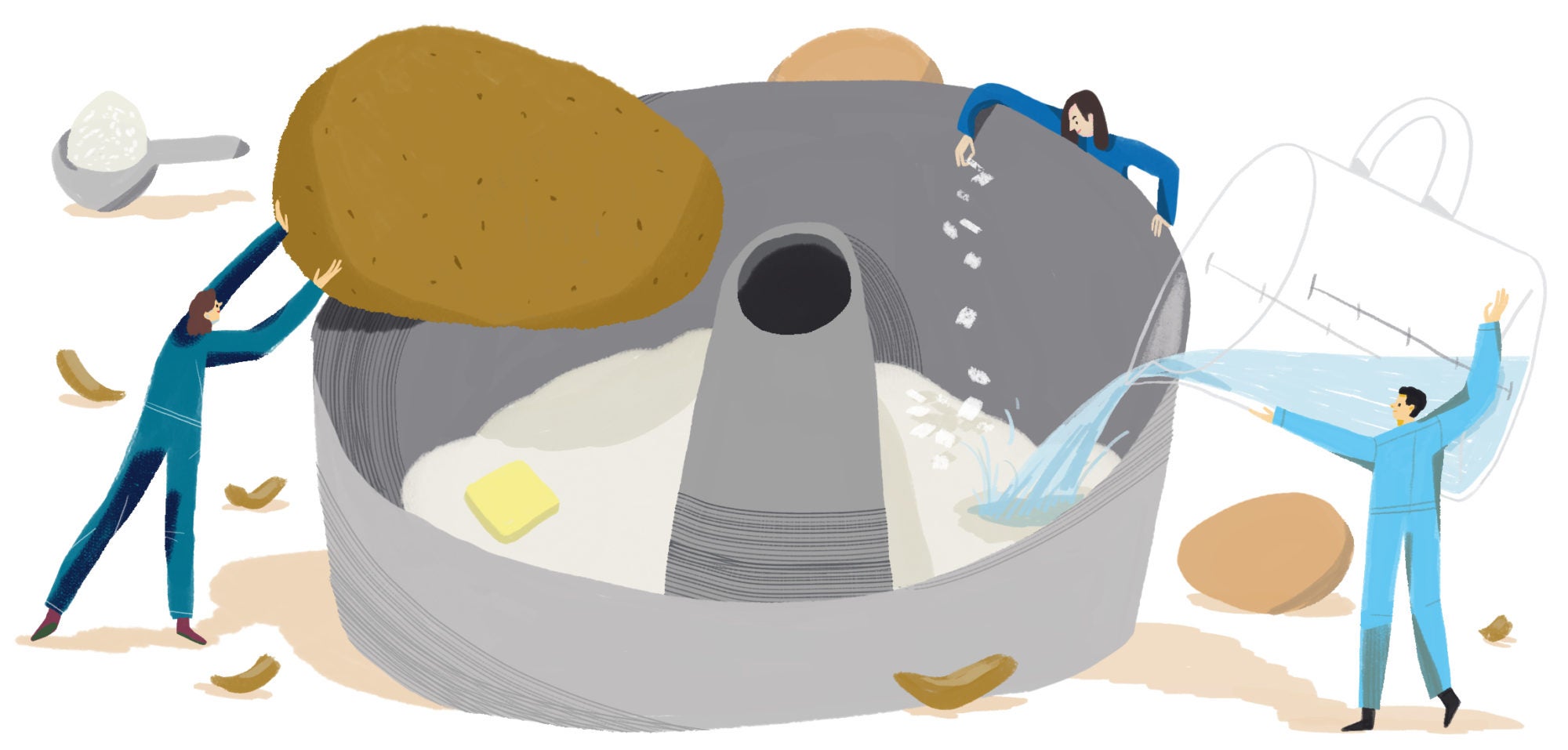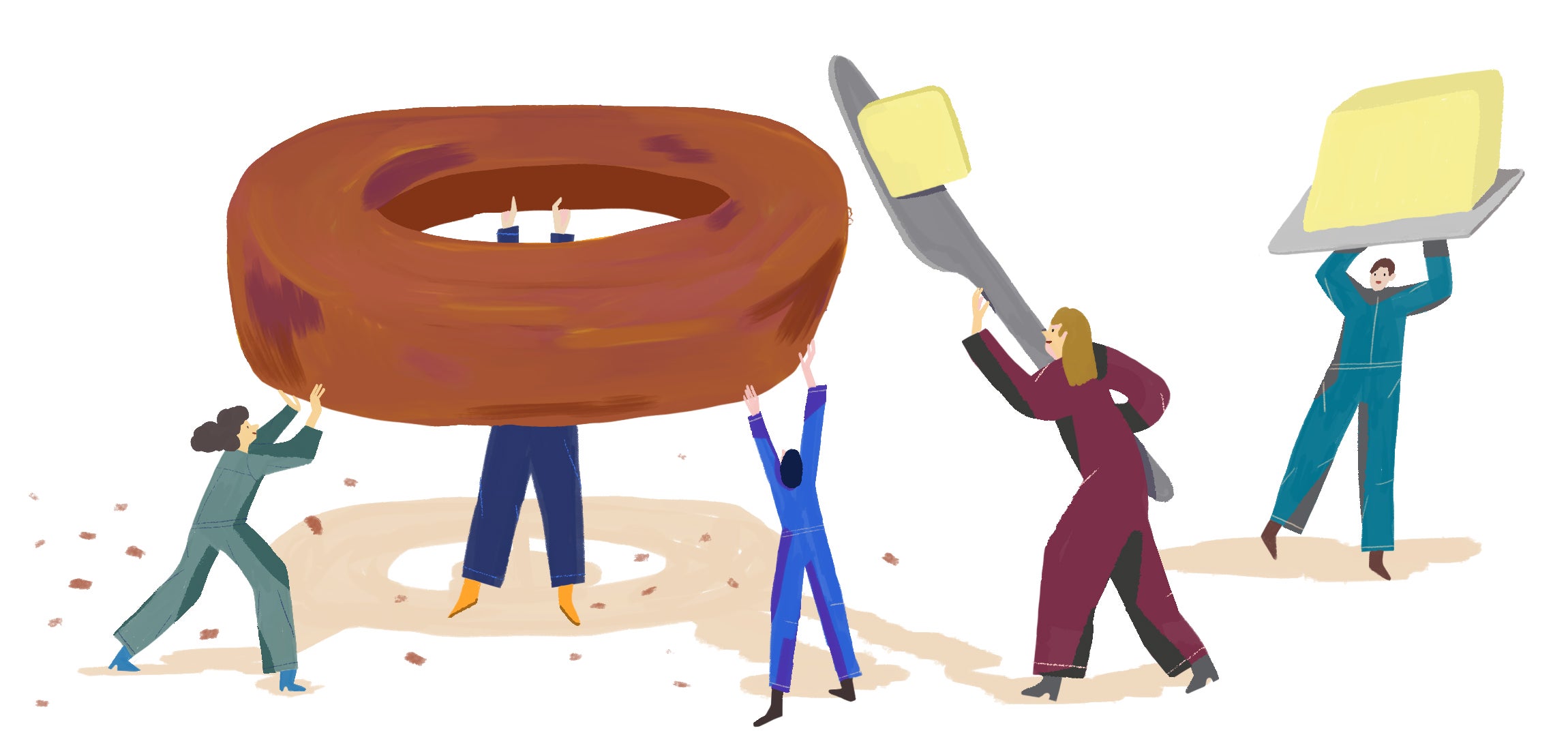
A writer searches for the golden euphoria of toch, a potato-bread recipe lost in a family’s history.
I grew up hearing stories of toch. My dad, who moved to Israel from Romania with his mom and sister after World War II, would tell me from the time I was a little girl about how delicious his mom made it, how buttery and crunchy the crust was—like the crispy edges on a perfectly fried latke. How it was moist and spongy on the inside, a little salty, and best still warm and steaming with a generous swipe of butter across the cut side. Toch (rhymes with poach) is a yeasted potato bread baked in a tube pan (the kind you use for angel food cake), and as far as I can tell, no one on the face of the planet knows this food except for my family.
Until I was 18, toch was just a legend. Then we went to Israel and were greeted by my entire family and a houseful of food. The dining table was piled with the good stuff: beef lungs simmered in tomato-onion gravy, chopped liver, paprikash-style braised chicken, at least three kinds of eggplant salad, peppers cured in olive oil with loads of garlic. And there, in the middle of the table—glowing with its buttery, browned exterior—was the toch, golden and statuesque. We sliced it, still oven-warm, and I slathered it with butter, took a bite, and experienced the purest form of carb-y happiness.
On the spot, I convinced my aunt to teach me to make it and stood by her side, with my notebook at the ready, forcing her to reveal ingredients and measurements and to talk me through the process from top to bottom. When I returned home, I tried it on my own, converting grams to ounces and cups, Celsius to Fahrenheit, and using American AP flour and russet potatoes, which are different than what you find in Israel. Reader: The toch was awful. It was heavy; it was dense; it tasted like raw potato and flour and was actually gray on the inside. I choked a bite down and threw away the rest. I put the recipe aside and decided that toch would have to be something I enjoyed in Israel and in Israel only.
Fast-forward two decades. My dad got sick and died, his death leaving a massive hole in my heart. Toch couldn’t just be something I ate in Israel. No, now it became an obsession, a recipe I had to get right because it was a way to remember and honor my dad and his love of this potato bread. I started a WhatsApp group called “The Israelis” made up of a half-dozen cousins, my aunts, and my brother and started barraging them with photos of toch, videos of the dough, and lots and lots of questions.
It had been so long since I made the first toch that I felt like I needed to make it again verbatim from the faulty recipe, just to understand better what needed to be fixed. (The difference between now and then: Then, I was an eager food-curious 18-year-old; now I am a devoted recipe geek and cookbook author.) On this go-round, I replicated the first toch I ever made, successfully baking off a dense, dry potato brick. I texted The Israelis a photo. “Use more potatoes,” said one aunt (counterintuitive, but I rolled with it). “Only squeeze the juices from half the shredded potatoes,” said the other aunt (I had laboriously wrung out all the potato water, which was apparently a bad move). “Add another egg,” said a cousin (everyone has an opinion when it comes to toch).

They started sending me audio messages in Hebrew and English to guide me through the process. One time I even posted some photos on Facebook hoping someone, somewhere knew what the heck I was trying to achieve and could offer some guidance. “That’s a kugelish,” said Gabriella Gershenson, a friend and fellow food writer. “Looks like a potato nik,” said cookbook author Leah Koenig. I looked up “nik” and discovered it was kind of toch-like, though Mark Bittman’s version published in The New York Times didn’t use yeast and looked like a giant latke baked in a cake pan. My cousin Rhoda from California chimed in, saying her mom (my grandfather’s sister) baked it in a square pan and that it should be very, very buttery. People offered ideas and advice—try it with potato flour, try a different kind of potato, try with cake flour or bread flour instead of all-purpose.
It was beginning to feel futile, and I was up to my ears in toch, even using it to make avocado toast. Would I ever get it right?
Then one of my Israeli cousins announced a trip to Brooklyn. Yes! Now was my opportunity to test in my kitchen, with a taster right next to me.
I grated the potatoes (four, not two!); I squeezed out half the liquid; I added the extra egg. I heavily greased the tube pan with butter and poured more melted butter over the top of the dough. I baked and de-panned it. The crust was near black—I had obviously messed up some Celsius-to-Fahrenheit conversion and baked the damn thing too long. But when we cut it open, on the inside, the toch was perfect.
“This is it!” said my cousin.
“Well,” I sighed, “it’s closer. But not quite right. It’s too dark, it’s too crusty….”
It was then that I realized that it wasn’t just the final bread that was important. It was the very act of connecting with my cousins, talking to my aunts, sharing the ins and outs of the recipe that meant so much to all of us. It was the conversation, not the toch, that was making me feel closer to my dad and filling that hole in my heart—not completely, but some.
“Should we send a photo to Mom?” said my cousin.
“Definitely,” I said. “Once I get the toch,” I added, “think she’ll show me how to make cholent next?” I spread some butter on a slice, and we sent the photo off to the other side of the world.